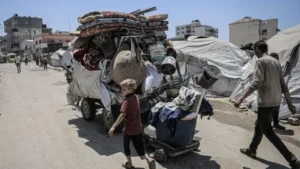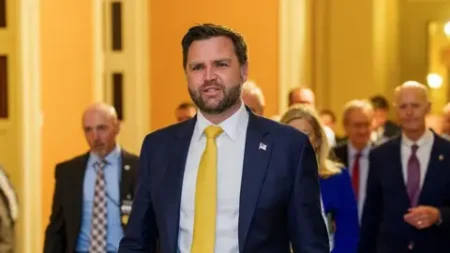In recent days, the complex and tragic situation in Gaza has escalated further, as Israel issued orders for Palestinian residents to evacuate from key areas in northern Gaza. This directive comes in the wake of heightened military action, prompting a significant humanitarian concern for the civilians affected. As reports emerge of the consequent fatalities, including children, the involvement of international figures, particularly U.S. President Donald Trump, has added to the urgency of calls for a ceasefire.
The Israeli military’s orders highlighted the urgency of the situation, with inhabitants in neighborhoods across Gaza City and Jabalia advised to relocate southward to the coastal zone known as al-Mawasi. This shift is a direct response to what are described as escalating military operations that aim to expand westward. With a grim toll, the Hamas-run health ministry reported at least 86 deaths attributed to Israeli attacks within a 24-hour span before midday on Sunday. Among those casualties were three children, killed in a purported strike on the so-called “safe zone” of al-Mawasi, an area where many civilians sought refuge.
President Trump has publicly emphasized the need to “make the deal in Gaza” while focusing on securing the release of hostages held by Hamas. On his social media platform, Truth Social, Trump referenced active negotiations purportedly underway between Israeli Prime Minister Benjamin Netanyahu and Hamas. Trump’s continued engagement in the dialogue and his hope for a ceasefire reflects an increasing international awareness and intervention in the ongoing conflict.
An Israeli military spokesman, Avichay Adraee, stated that the objective of operations in northern Gaza is to eradicate terrorist elements and infrastructure. However, local medics and residents reported an uptick in military bombardments, particularly over the weekend, resulting in significant destruction of residential buildings and tragically claiming more civilian lives. The Hamas-controlled civil defense agency updated that at least 23 individuals died on one day alone, with specific incidents, such as an Israeli air strike targeting displaced persons in al-Mawasi, leading to multiple fatalities within a single family.
The aftermath of these strikes has led to heartbreaking testimonies from families caught in the crossfire. One mother, Iman Abu Maarouf, lamented the loss of her children after an attack while they were sleeping, underscoring the human cost of such military operations. Her husband echoed the sentiments, sharing their plight after having relocated to the “safe zone” at the Israeli military’s behest.
The Israeli Defense Forces (IDF) stated that precise details about specific incidents may not be available promptly, asserting their commitment to operate within the bounds of international law while taking steps to mitigate civilian harm. Nevertheless, the backdrop of increased military activity complicates the environment and raises significant concerns about the safety and well-being of the civilian population.
As ceasefire negotiations remain stalled, efforts intensify among international mediators to facilitate a resolution that not only addresses the immediate conflict but also the humanitarian crisis unfolding as food and medical shortages escalate in Gaza. Trump’s engagement in this process, coupled with Netanyahu’s comments about the potential for broader regional opportunities, reveals a complex web of political maneuvering in the pursuit of an end to hostilities.
It is essential to point out the improved humanitarian framework proposed, such as the Gaza Humanitarian Foundation (GHF), designed to manage aid distribution amidst the crisis. Yet it faces criticism from international observers who question the efficacy and safety of aid distribution. The United Nations, along with humanitarian experts, urge that aid efforts continue through established channels to ensure the protection and welfare of civilians.
In summary, the situation remains extremely volatile, with rising fatality counts, a continued military presence, and emerging international dialogue underscoring the urgency for a ceasefire. The plight of civilians, the strategic decisions of military and political leaders, and ongoing efforts for humanitarian aid converge in what is a deeply complex humanitarian crisis, demanding immediate and sustained attention on all fronts.











